Last June, Cary, Ill.-based Sage Products asked for a voluntary recall of certain lots of a preoperative skin preparation product. For Sage, a manufacturer of personal care products sold to hospitals and medical practitioners, the measure was precautionary: A batch of chlorhexidine gluconate, bought from an outside supplier, had been found to contain the burkholderia cepacia bacterium.
Last June, Cary, Ill.-based Sage Products asked for a voluntary recall of certain lots of a preoperative skin preparation product. For Sage, a manufacturer of personal care products sold to hospitals and medical practitioners, the measure was precautionary: A batch of chlorhexidine gluconate, bought from an outside supplier, had been found to contain the burkholderia cepacia bacterium.
While the bacterium posed little medical risk to healthy people, the incident underscored the wisdom of an investment Sage had made in a rapid testing system from Celsis that enabled Sage to detect microbiological contamination far faster than was possible using conventional testing methods. Using the Celsis system, a test that once might have taken three to seven days to conduct—while possible biological contaminants grew to detectable levels—can take place in under 24 hours.
In the wake of high-profile product recall scares ranging from vegetables and peanut butter to children’s bath products and cribs, supply chain risk is center-stage. Businesses are under renewed pressure from customers to strip the risk from their outbound supply chains even as they acknowledge the vulnerability of their inbound supply chains. The result is a profound emphasis on technology as manufacturers rush to play catch-up in a world that is suddenly far riskier than many had realized.
Many observers
A recent IBM survey on "smarter supply chains," based on interviews with 400 senior supply chain executives, found that dealing with supply chain risk was the second-highest priority on their agendas, and "significantly" or "very significantly" affected 60 percent of businesses involved.
The finding "was a huge surprise," says Karen Butner, supply chain management lead at the IBM Institute of Business Value. "Not that it was on the agenda—but that it was supply chain executives’ second-biggest concern."
According to Butner, IBM is seeing heightened interest from companies in anything that has to do with risk identification and mitigation. Manufacturers are looking at their supply chains and putting contingency plans in place. "If there’s going to be a problem, they want to know in advance what they are going to do about it," she says.
The recession only exacerbates the risk of those problems arising.
"With the economic recession in full swing, supply chain managers face a growing array of risks," warns David Simchi-Levi, professor of engineering systems at Cambridge, Mass.-based MIT, and chief scientist for supply chain optimization vendor ILOG , an IBM company.
"Fluctuating transportation costs, high volatility in demand volume and mix, commodity price volatility, increased labor costs in developing countries, and the pressure to reduce inventories—these are just a few of the challenges companies are struggling to overcome today and will likely face throughout 2009," Simchi-Levi adds.
Greg Quinn, president of Quinn & Associates , a reseller for planning & scheduling solutions vendor Preactor in North America, says rising supply chain risks are forcing manufacturers to focus more the use of supply chain execution systems, which provide a greater ability to respond to immediate circumstances, as opposed to supply chain planning systems, which focus more on long-term time horizons.
"We’re seeing a lot more interest in execution systems," Quinn says. "It’s like someone has flipped a switch."
The good news is, despite the common perceptions, eliminating risk needn’t always add cost. When St. Louis-based coatings manufacturer U.S. Paint deployed Preactor to minimize the risk of outbound supply chain disruption impacting the North American operations of Toyota, Subaru, and Kawasaki, costs went down and efficiencies went up.
"As on-time delivery performance improved, they found that they could eliminate work-in-process and finished goods inventory without jeopardizing delivery reliability," notes Quinn. "It became a virtuous circle."
New kind of crisis
Supplier viability is another heightened risk factor in the present economy. New York-based advisory firm PricewaterhouseCoopers, for example, estimates 670,000 small companies have shuttered across China due to the global crisis—with many of them linked to Western supply chains.
But nearer home, transport provider viability is a growing concern, adds Mike Maris, senior director of the global transportation and logistics group at Schaumburg, Ill.-based Motorola. "There’s something of a crisis in the transport sector," he notes. "In North America alone, up to a thousand transportation companies have gone out of business."
And when those transport companies are tied into enterprise networks through outsourced contract operations, disruption follows. Third-party logistics provider Ryder System, for instance, has been called upon to provide back-up service to a major office equipment manufacturer, supplying system-savvy logistics personnel familiar with its ERP system in the event of a depot’s local transport provider going out of business.
Covering up to 50 service depots nationwide, the service has been invoked twice during the last few months, says Jim Moore, VP of supply chain solutions at Ryder. "We peel people off, put them on a plane, and fly them to wherever the problem is," he says.



